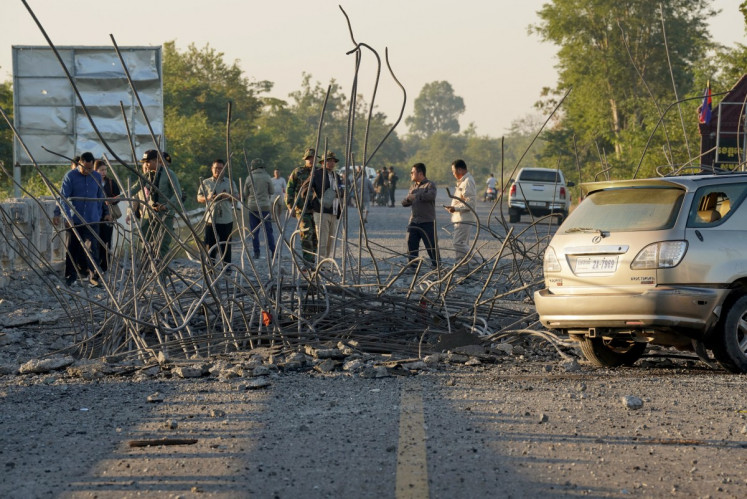Popular Reads
Top Results
Can't find what you're looking for?
View all search resultsPopular Reads
Top Results
Can't find what you're looking for?
View all search resultsMira-Riri duo brings 1990s back with ‘Bebas’
Action!:Director Riri Riza (left) and actress Marsha Timothy film Bebas on the Jakarta MRT on April 16
Change text size
Gift Premium Articles
to Anyone
Action!:Director Riri Riza (left) and actress Marsha Timothy film Bebas on the Jakarta MRT on April 16.(Courtesy of Miles Films)
Producer Mira Lesmana’s latest film Bebas (Free) is set to bring audiences back to the 1990s with a focus on high school friendships.
Directed by Riri Riza, Bebas is slated to hit theaters on Oct. 3. The movie is an adaptation of the 2011 South Korean film Sunny.
The plot sees stay-at-home-mom Vina (Marsha Timothy) trying to get her high school gang — the eponymous Bebas — together for one last reunion before member Kris (Susan Bachtiar) succumbs to a terminal illness.
According to Mira, she wanted to set the film in the 1990s as it was a meaningful decade for both her and Riri, noting that their debut as directors came in the era with the 1998 film Kuldesak (Cul-de-sac).
Riri said the idea to adapt Sunny came from Korean distribution company CJ Entertainment, which had screened Ada Apa Dengan Cinta? (What’s Up With Cinta?). Sunny was a movie the company wanted to be remade in numerous countries.
“The story is relevant enough to be made into an Indonesian movie, as went through a [similar] memorable experience in high school. For me, recreating a 1990s high school experience — but one that’s still contemporary — is [to make a] shared experience we’ve all been through,” she said.
Bebas’ storyline closely follows that of Sunny, from the where-are-they-now plot device right down to the ending scene. However, some details were changed in order to fit Bebas into 1990s Indonesia.
Like the original source, one scene calls for a backdrop of violent uprisings, in Sunny’s case, it was the 1980 Gwangju Uprising. The obvious case for 1990s Indonesia would be the May 1998 riots, yet Bebas is set in 1995 and the scene is swapped for a brawl between rival schools, ubiquitous of the era.
Mira, who also wrote the script, said that though 1998 would be the most obvious choice, she thought the backdrop of the spirit of freedom held by the gang would be insensitive to the economic recession of the time.
“From 1997 to 1998, it was quite somber. On the other hand, 1995 to 1996 was the peak of pop culture, when teenagers even had their own lingo. However, there were also brewing anxieties as expressed by one character who refers to the muzzling of Tempo and Detik and the rise of the [then-forbidden People’s Democratic Party] PRD.”
“I think [1995-1996] was the right moment, as at that time, Indonesians were looking for a new kind of freedom,” she said.
Aside from the general zeitgeist of the era, Bebas also strives to present the 1990s through details such as music. Most prominent is its theme song, rapper Iwa K’s 1994 hit “Bebas”, presented alongside other hits like Kahitna’s “Cerita Cinta” (Love Story) and Vina Panduwinata’s “Aku Makin Cinta” (I Love You More).
Mira noted that it was these small details that were the most difficult to get right, as the crew needed things like a vintage Game Boy to set the mood, as well as background sounds familiar to 1990s kids like kue putu (green, cylindrical-shaped steamed cake) sellers or oil vendors.
“One of the hardest was finding a radio host. We looked at several hosts to fill the role, but none felt truly 90s, so I went with [Arlingga “Angga” Panega], who was a radio host for Prambors in the era,” she said.
Meanwhile, Riri added that he had six months to research the details with the film’s art department while the script was being worked on, including finding “authentic” filming locations in Jakarta and recreating food and drink packages that had gone out of production.
“What’s most important is strategy because it’s not feasible for me to have 20 cars on the road at the same time, so we have to pick a certain corner that doesn’t show the modern background,” he said, adding that filming took place in Menteng and Pasar Baru in Central Jakarta, and Blok M and Kebayoran in South Jakarta.
Another aspect Mira took into consideration was how the movie would represent a specific generation through the cast.
Unlike Sunny’s all-female cast, one of the members of the group was turned into a male character named Jojo, portrayed by Baim Wong in adulthood and Baskara Mahendra as a teenager.
“In the first draft of the script, I already established the characters, the songs and everything. After we brought [scriptwriter] Gina [S. Noer] in, the first [problem] we gave her was that the story didn’t represent a public school — the setting felt more like an all-girls school instead,” Mira said, noting that single-sex schools are more common in South Korea.
The question was, she continued, how to create a male character who is part of a circle of friends that is mostly composed of girls.
Other characters that got the gender-swap treatment were the school “bullies”, which Mira felt would be more “local”.
“This turned into an additional statement on how men respect women and how women view men. Jojo represents a man who respects women in that he’s willing to be part of the group and that these women trust him back,” Mira said.
“As for his personality, we didn’t want to make him too specific as it was a portrait of the times. Whether they accept him, maybe it’s only the people in his closest circle that do.”










